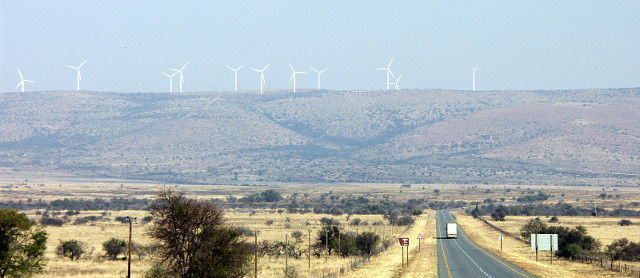South Africa has been in the press for all the wrong reasons. The grid is failing due to lack of upkeep and ‘new build’. There are concerns about corruption and overspending ahead of a massive planned nuclear fleet. And private energy interests are scouting around the water-scarce Karoo for shale gas. What hasn’t had as much media time is the fact that large-scale renewable plants are coming on-stream fast. Local science writer Leonie Joubert takes a closer look.

Renewable energy growth is on the horizon for South Africa. (Photo by NJR ZA, CC BY-SA 4.0)
My mobile has just ping-ed. It’s a message from a phone app, saying that the electricity in my suburb in Cape Town will be switched off between 8am and 10:30am again today. Thank goodness I’m not on deadline, but I’ll still need to hurry to download the research I need this morning, so I can work offline until the power comes back on.
This is how the South African state utility, Eskom, is handling the fact that it can’t keep up with demand during peak electricity hours. We call it ‘load shedding’, where the utility switches off parts of the grid at different points around the country to ease the load. It’ll keep on doing this for the next few months, until all the respective power plants have had urgent maintenance done and are up and running at full capacity once more.
Delays in building the new mega-power station, Medupi, in the Limpopo province, means this new coal-fired plant isn’t able to pick up the slack yet.
To deal with the crisis, Eskom has worked out a schedule for how the load shedding will happen, so that people can at least plan their days around the managed outages. This has become every life for South Africans as we head into winter.
According to the South African government’s Integrated Resource Plan – the blue print for how it will fire the grid for the next few decades – the energy department reckons we need to be able to generate between 345 TWh (terawatt-hours) and 416 TWh of electricity by 2030. This will be done mostly with coal, gas turbines, and most likely new nuclear.
But some of this power is intended to come from renewables – mostly hydropower, concentrated solar, photovoltaic solar, and wind. And this is where the exciting developments are – because the ‘new build’ on the renewable front has already started, and is proceeding with such speed that it’s almost hard to keep up.
These ‘utility-scale’ renewable plants are part of a four-phase Renewable Energy Independent Power Producer Procurement Programme (REIPPP) which started in 2011 and aims to be able to feed 3,725 megawatts of uninterrupted power into the grid, according to the Minister of Energy.
Private energy companies have been invited to submit projects in four rounds of bidding, the first of which opened for bidding in August 2011. The fourth round of preferred bidders has just been announced this April. This means there are now 79 projects either already operational, being built, or having the final details wrapped up on the planning and finance. Most of the first and second round projects are already up and running.
Have a look at this interactive map, which shows where all the projects are being built. The Energy Blog also gives a good breakdown of each project.
The speed with which these private-sector initiatives are being built is in step with a recent Bloomberg report which states that, globally, ‘(t)he race for renewable energy has passed a turning point. The world is now adding more capacity for renewable power each year than coal, natural gas, and oil combined. And there’s no going back.’
South Africa is a game-changing state in Africa. It is the strongest economy on the continent, but its growth is due to a mining and manufacturing sector which was built on its abundance of cheap and dirty coal. (According to a World Bank Institute and University of Cape Town report, ‘coal supplies approximately 70 percent of the country’s primary energy and more than 90 percent of its electricity’.)
South Africa produces nearly half of the entire continent’s carbon emissions, and therefore has an obligation to lead its neighbouring developing states towards a lower carbon growth path. At the same time, it is one of the BRICS members – not because of its economic clout, relative to the other partners in the bloc, but because the rest of BRICS recognise the leadership role and development potential that South Africa has, relative to the rest of the continent.
It’s interesting times, for sure, down here on the southern end of the continent.
Leonie Joubert is a science writer and journalist, and currently works as a fellow with the University of Cape Town’s Environmental Humanities of the South, where she is looking at the political economy of the food system in her country.